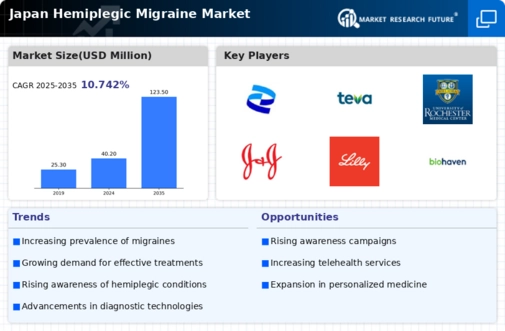The Japan Hemiplegic Migraine Market is characterized by a growing competitive landscape, driven by the increasing recognition of hemiplegic migraine as a significant health concern. With a rise in awareness about migraine disorders and advancements in therapeutic technologies, various pharmaceutical companies are positioning themselves to capitalize on this niche market. The demand for effective treatment options tailored specifically for hemiplegic migraine sufferers is fostering an environment conducive to innovation and competition.
These market dynamics have led to an influx of research and development activities aimed at understanding the underlying mechanisms of hemiplegic migraine and creating targeted therapies that address both preventive and acute treatment needs.GlaxoSmithKline has established a notable presence in the Japan Hemiplegic Migraine Market, showcasing its commitment to addressing the unique challenges posed by this condition. The company's strengths lie in its extensive research capabilities and a strong portfolio of innovative therapies. Leveraging its global expertise in migraine treatment, GlaxoSmithKline continuously works to enhance patient outcomes through the development of effective medications.
Their focus on evidence-based solutions and dedication to patient education has positioned them as a key player in Japan's hemiplegic migraine therapeutic options. Moreover, the company actively engages in partnerships and collaborations to further enhance its product offerings and market reach, reflecting its strategic positioning within the competitive landscape.Amgen, on the other hand, also plays a significant role in the Japan Hemiplegic Migraine Market, with a portfolio of key products designed to alleviate the burden of this debilitating condition. Known for its innovative biotechnology approach, Amgen focuses on developing therapies that leverage advanced biological insights in migraine treatment.
Their strengths include a robust pipeline of products that are specifically engineered to target the pathophysiology of hemiplegic migraine, which positions them well within the Japanese market. Additionally, Amgen has been involved in strategic mergers and acquisitions aimed at enhancing its capacity to deliver cutting-edge treatments to patients. This commitment to innovation, along with a strong distribution network in Japan, allows Amgen to maintain a competitive edge in addressing the unique needs of hemiplegic migraine patients.
The combination of a strong R&D pipeline and localized strategies provides Amgen with a solid foundation to thrive in this specialized segment of the market.






















